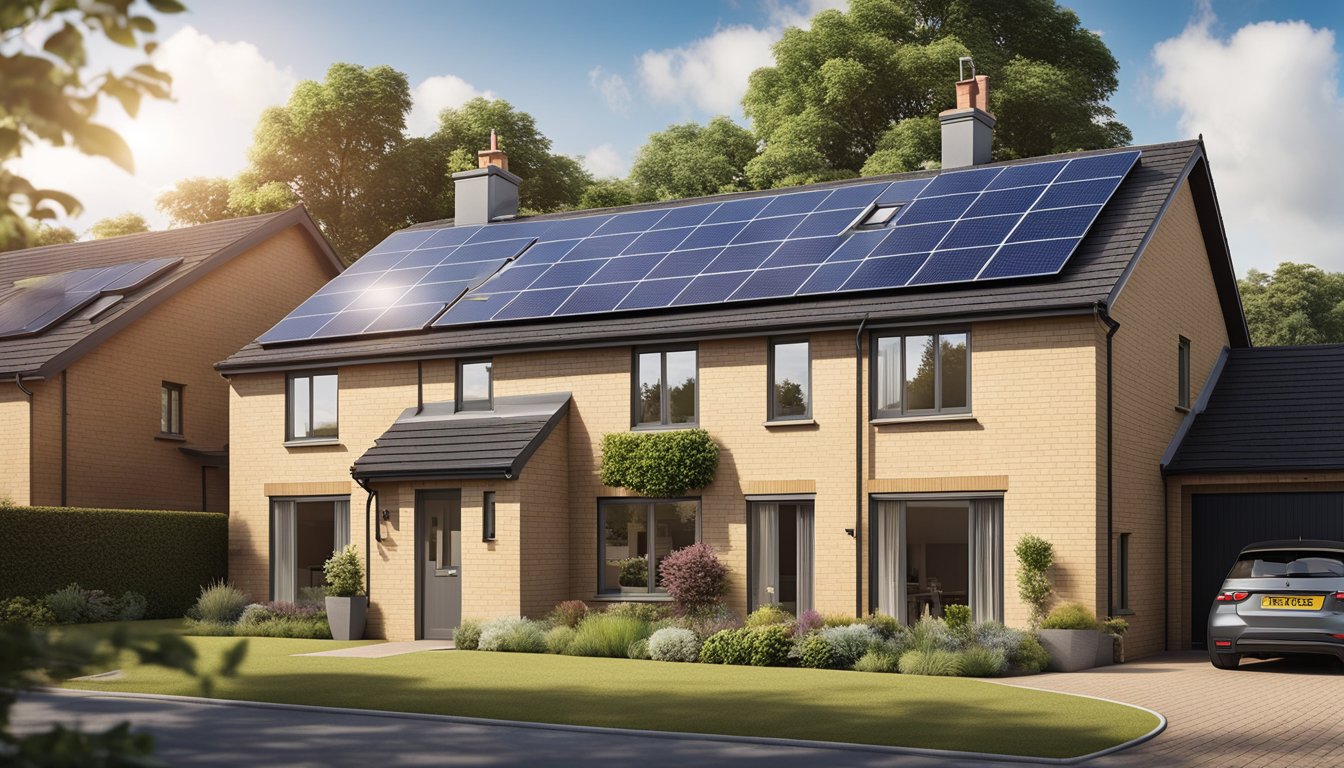Late updated: 04 May 2025 13:05
Written by: Eleanor Hartman
Innovative Ways To Enhance UK Home Energy Efficiency: Transforming Your Living Space
Enhancing home energy efficiency is crucial in the UK, given the growing emphasis on sustainability and cost-saving measures. With a mix of traditional techniques and modern technology, we can transform our homes into more energy-efficient spaces. Draught-proofing windows and doors stands out as one of the simplest yet most effective ways to conserve energy. By implementing these changes, we not only cut down on energy bills but also contribute positively to the environment.

In addition to draught-proofing, homeowners can explore the installation of energy-efficient appliances and smart meters, which provide better visibility into energy consumption. These innovations allow us to make informed decisions and optimise our energy usage. Implementing these solutions helps us stay ahead in achieving an eco-friendly home environment.
The role of government initiatives cannot be underestimated, as they often provide guidelines and incentives for energy efficiency improvements. By staying informed about available grants and policies, we can maximise our efforts towards creating more energy-efficient living spaces.
Key Takeaways
- Draught-proofing is vital for energy conservation.
- Energy-efficient appliances and smart meters enhance home efficiency.
- Government incentives support energy efficiency improvements.
Fundamental Strategies for Improving Home Energy Efficiency

Enhancing energy efficiency in homes is pivotal for reducing energy consumption and costs. We can optimise our homes with effective insulation, smart technology, and conscious behavioural changes.
Effective Insulation Techniques
Insulation serves as a critical barrier against heat loss or gain in our homes. Properly insulating lofts, walls, and floors can significantly cut energy usage by maintaining desired temperatures. Many UK homes benefit from loft insulation, and the addition of cavity wall insulation further enhances energy efficiency. Insulating floors and hot water cylinders prevents unnecessary heat escape.
Utilising insulation materials like mineral wool or rigid foam boards increases the effectiveness of thermal barriers. Draught-proofing windows and doors complements insulation efforts, preventing cold air from seeping indoors and warm air from escaping. These practices are especially beneficial for reducing fuel poverty, ensuring homes remain comfortable with less energy demand.
Smart Thermostat and Meter Integration
Integrating smart technology is instrumental in managing our home's energy consumption. Smart thermostats allow for precise temperature adjustments, learning our routines to optimise heating schedules and reduce wastage. This leads to substantial energy savings over time.
Pairing smart thermostats with smart meters offers further advantages. Smart meters provide real-time insight into energy usage, allowing us to identify high-consumption patterns. By understanding and adjusting these patterns, we can minimise unnecessary energy expenditure. These tools empower us to make informed decisions, maximising home energy efficiency while reducing bills.
Optimising Energy Consumption through Behavioural Changes
While technology and materials are crucial, our behavioural patterns significantly impact energy efficiency. Simple adjustments, like switching off lights when leaving a room or unplugging idle electronics, contribute to lowering energy consumption. Encouraging family members to adopt these habits as a routine maximises energy savings.
Additionally, opting for LED lighting, which consumes less power than traditional bulbs, contributes to efficient home energy use. Regular maintenance of appliances ensures they operate effectively, further reducing unnecessary energy usage. By fostering an energy-conscious mindset, alongside the implementation of technology, we create an environment where energy efficiency measures are naturally prioritised in our daily lives.
Advanced Innovations and Policy Drivers Shaping UK Energy-Efficient Homes

As the UK pushes towards reducing carbon emissions and achieving net zero, innovative technologies and strong policy frameworks are playing integral roles. These elements not only aim to boost energy efficiency within homes but also seek to align with broader environmental and economic goals.
Adoption of Renewable Energy Solutions
Renewable energy, such as solar and wind, has become fundamental. Photovoltaic panels on rooftops and small-scale wind turbines can significantly curtail reliance on fossil fuels.
In the private rented sector, these technologies not only enhance energy efficiency but also add significant value to properties. Investment in smart grid technologies and battery storage solutions further bolsters the effectiveness of renewable installations, ensuring surplus energy is stored for later use.
Key Elements:
- Solar Panels: Decrease electricity bills and carbon output.
- Wind Turbines: Suitable for rural and urban settings alike.
- Energy Storage: Essential for managing supply and demand efficiently.
Meeting Net Zero and Energy Efficiency Targets
Meeting UK’s energy efficiency targets and net zero ambitions necessitates a multi-faceted approach. Supply chain optimisation plays a crucial role by reducing the environmental impact associated with manufacturing building materials.
Our homes need to be retrofitted with high-performance insulation and advanced glazing to enhance thermal efficiency. Zero carbon homes are no longer just a concept but a burgeoning reality facilitated by innovative building techniques and eco-friendly materials that curtail energy consumption drastically.
We must also advocate for digital technologies that monitor and adjust energy usage, which are vital in minimizing waste.
Legislation and Investment for a Sustainable Environment
Strong legislation is key in driving the changes we wish to see in the housing market. The Labour government has proposed ambitious targets and policies that require investment in low-carbon technologies.
Private investments have been encouraged through tax incentives and grants, aiming to make green renovations more accessible for homeowners. Furthermore, the supply chain's commitment to sustainability broadens the adoption of energy-efficient practices across all stages.
Government-led initiatives and private sector collaboration ensure a robust framework for empowering citizens and businesses to invest in environmentally responsible energy solutions. Bold, strategic actions are critical in safeguarding our future and fostering a sustainable environment.
Frequently Asked Questions

Energy efficiency in UK homes can be significantly improved through a variety of methods, including better insulation and government-backed initiatives. Let's explore essential questions regarding these improvements.
What initiatives are in place for improving home insulation in the UK?
To enhance insulation, there are several schemes like the Energy Company Obligation (ECO4), which supports homeowners in upgrading their property's insulation. This initiative helps reduce energy costs and increase efficiency by providing financial assistance for implementing measures such as loft and cavity wall insulation.
How can I apply for government-sponsored energy efficiency grants for my home?
Homeowners can access grants through various government schemes aimed at subsidising energy efficiency improvements. To apply, visit official websites like GOV.UK for detailed guidance on eligibility and the application process. These grants can cover costs related to insulation, boiler upgrades, and more.
What are the best practices for reducing electricity consumption in British households?
Simple changes, like switching to energy-efficient LED bulbs and using smart thermostats, can lower electricity usage. It's also effective to unplug devices when not in use and to utilise energy-efficient appliances. These practices contribute significantly to reducing energy consumption and bills.
What steps should be taken to make a UK home more energy self-sufficient?
Improving self-sufficiency involves installing solar panels and adopting rainwater harvesting systems. Integrating renewable energy sources, such as solar or wind, can drastically cut dependence on external energy supplies and reduce carbon footprints, making homes greener and more sustainable.
How does the Energy Performance Certificate (EPC) contribute to home energy efficiency?
The EPC provides an energy efficiency rating for homes, indicating potential for improvement. It's a useful tool for homeowners to understand current efficiency levels and identify cost-effective upgrades. Better ratings often translate to higher property value and lower energy costs.
Which home improvements are covered under the UK's energy-saving schemes?
UK schemes typically cover upgrades like installing modern heating systems, applying better insulation, and fitting double glazing. These improvements enhance energy efficiency, aiding in cutting both carbon emissions and household energy costs. Schemes like ECO4 focus on these measures to support homeowners financially.